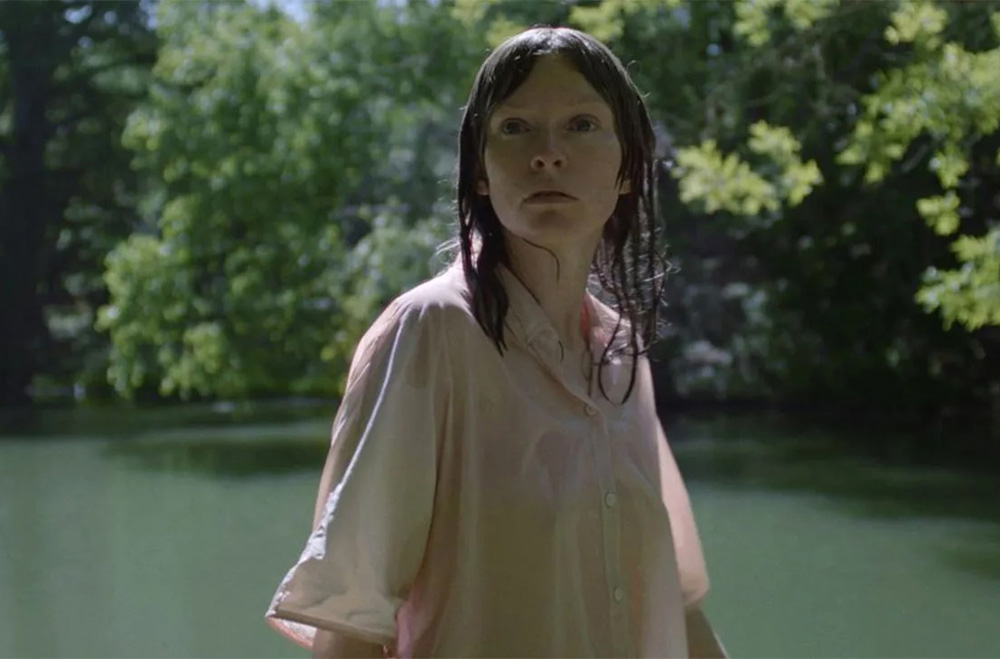The only thing that was less likely to sit still than any member of Lucy Kerr’s family was the thought that ran through her head after watching her extended brood attempt to take a photo for their holiday Christmas card. There were the unruly children run across the grass on her grandparents’ sprawling estate in Texas, with the eldest members of the family impatient to get the photo taken so they could return to sit inside the house and those around her age scrambling around to try to bring some order to the chaos, yet none with exactly the same aim in mind – perhaps a more accurate reflection of what the relationships were like year-around than what would be expressed in the picture that was ultimately taken.
It was the starting point for Kerr’s engrossing feature debut “Family Portrait,” which saw the director return exactly to the same spot where she once posed with her own relatives for a gently surreal drama starring Deragh Campbell as Katy, one of three sisters that has made their way back to their parents’ compound in advance of the holidays for a gathering that hardly ends up feeling like a celebration. While siblings Annabelle (Rachel Ali) and Grace (Katie Folger) each have kids and stayed closer to home, Katy can’t help but feel a bit adrift when she’s clearly pursued a different path, bringing back her boyfriend Olek (Chris Galust) of Eastern European heritage that gives her parents pause about offering him a Mexican breakfast, and unnerved by cacophony of having so many people under one roof, something she thought she left behind. She’d like the trip to be over as quickly as possible, but that can’t happen until the picture is taken, which can’t happen because her mother (Silvana Jakich) has mysteriously disappeared mid-day.
Although Kerr’s film isn’t autobiographical beyond the inspiration for its premise, it seems safe to say the distinctive personal expression is all hers as a world that is inherently familiar to Katy suddenly is turned upside down once her mother isn’t around and the filmmaker who came to the artform by way of a number of other mediums draws on all the senses available to her to experience Katy’s unraveling so vividly. Running a fleet 73 minutes, “Family Portrait” is expansive in other ways when compositions and conversations can reveal the distance between characters, all present out of a natural concern for one another but growing apart when just as naturally they have evolved into their own people separate from the bloodline they were born into. With the film now returning to its country of origin after an impressive international festival run that began last fall at Locarno, Kerr spoke about the unusually affecting drama, blending her personal inspiration with what others could bring to the production, and why she was content to go with whatever way the wind was blowing on a given day of the shoot.
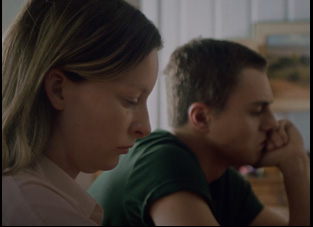
I started in dance and performance and choreography and when I was in New York 10 years ago, I was making a lot of dances and performances, but here in the city, I encountered so many amazing films. That brought me to film, and then I went to CalArts to study and when I was there, I studied film/video, which is the more experimental program, and I also made some documentary, but my documentary was always about performance. I went home for Thanksgiving break, and I brought a camera and tripod with me to make something for a class. The assignment was to make a film about a still picture, so I documented my family trying to take the family Christmas card, and everyone was wearing these crazy Christmas outfits and it took forever for everyone to come together finally to take the picture. People were all doing their own thing and it almost looked like a staged scene in a film.
That’s how this started and there were some narrative films that I always really loved, like “Beau Travail,” which I saw at Metrograph actually in 2016 and changed my life. I was like, “Oh, I want to make a film,” and then when I was at CalArts, I saw “La Cienega” and Lucrecia Martel came to CalArts, and I was able to do a one-on-one studio visit with her, and I showed her that footage of my family taking the picture. And then we discussed a possibility of creating a narrative film about the Christmas card, and then I took some years off not thinking about it, and then returned to it in 2020 when it was the lockdown, and I [thought], “Well, maybe it’s time to try writing something.” And on set, there was a lot of improvisation. Since it was such a contained environment, what I was interested in was being really open to how the film could expand. People had ideas on set, and I would think about them and Rob Rice, the directorial advisor, and one of the co-writers also, and Karlis Bergs, my husband, the three of us, were brainstorming together there, and I feel like [the setting] allowed us to do that.
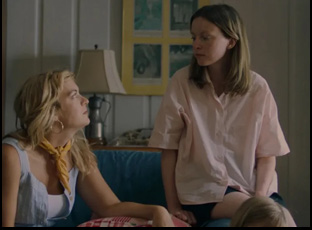
Yeah, I did the casting myself and tried to be really specific about each character and where they came from. It wasn’t about necessarily what their experience was or what they had been in in the past. It was more about where they live, and their relationship to Texas. I saw Chris in “Give Me Liberty,” where he plays a Russian-American driver, and he’s taking care of his grandfather who’s Russian, and that character [in “Family Portrait”] was always supposed to be Eastern European. My husband is from Latvia, so it’s related to that, and when I saw [Chris] in “Give Me Liberty,” I [thought], “Wow, he has such an interesting voice where you may sense English isn’t his first language since he has an accent, but not really.” So I felt he was a great fit for that character, who’s this outsider [to the family] as well as Katy, who’s not really an outsider, but something about her feels different, and that’s part of the reason Deragh being Canadian, I think, is interesting [as well as] being well-known in the indie film and arthouse film world and being transplanted to Texas [with these local actors].
The other actors I found over the course of two years, and a bunch of them are based in Texas. I loved working with everyone so much. Some of them knew each other, like the dad and two of the brothers-in-law. One of the brothers-in-law is from Kerrville, that area in Texas where the film is shot, and then I did an open call for the sisters because I didn’t want to go through agents — I always think that there are so many interesting actors out there that might not have an agent. And I loved working with everyone so much. Rachel Alig, who plays Annabelle, worked with Paul McCarthy, the visual artist, for about four years, so she has a lot of experience in experimental performance and then Katie Folger, who is from Texas as well, [plays] Grace, one of the sisters, so it was a very fun process of piecing it all together.
You make great use of the house and I understand it’s a place you knew well from your own childhood. What was it like to find the compositions inside of it?
Yeah, I know the house almost so well that it was hard to be objective about it because I grew up going there since I was a baby. But I brought the cinematographer Lidia [Nikonova] there for a really important weekend, maybe four months before we shot it and we were there for three days, just exploring every part of the house, and all over the field and the area across the river. Then we just did a lot of pre-visualization of these specific parts of the house. It was an interesting combination of my family history as well as this new family we were putting in there. Tim, the production designer, who was amazing and so detail-oriented, took pictures of everyone, and we put them in the frames, and we combined it with pictures of my family.
Houses like that pose some challenges, [with] the big windows and the difference in lighting, but it was really such a cool place to shoot. The house also has this feeling of community — I think that’s why it was built the way it was. Everyone mingles in the living room and the kitchen, and then the bedrooms are all off in the corners. We didn’t really shoot in there [because] a lot of stuff was being stored in there and we actually stayed in the house, so all the rooms were taken by people in the cast and crew, so it was really like a summer camp situation.
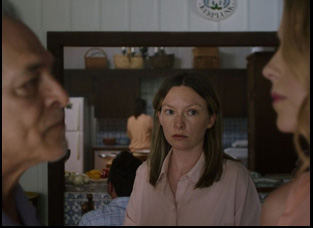
Yeah, and also Lidia really loves camera movement, so I think it was both of us coming together — my ideas in the beginning for this swath of people, like, almost like a landscape of people in this kind of chaos [where it’s not] everyone going crazy, but having their own little trajectories and inner worlds, and her feeding off of that and thinking about the relationship to Katy. In the first scene, the camera follows Katy, but then bounces off of her as she pulls people in different directions and that was something Deragh was thinking a while before we shot [about how] maybe if she’s pulling people like this, we get a sense of this bizarre urgency she has for this picture. So that film language was all built over time.
There were some limitations we had when we got on set, like we wanted to bring the steadicam across the river, but there was no way to get it across the river without having to put it in a canoe, and it was just too dangerous. But Lydia had thought ahead of time to get this really long Zoom lens, and Rob Rice, Karlis and I were thinking that we could create this feeling of following her with the Zoom lens. So I just tried to be really open and [while we were] really prepared with the camera movement shot list, I also didn’t want to be precious about it in the moment. There was a constant balance between those two. Camera movement is so powerful and something that maybe isn’t used enough in a way that’s not gimmicky, but also really sensorial. Lidia and I watched “Gerry,” the film by Gus Van Sant, a couple times where the steadicam shots are just so amazing, and a lot of those moving shots were inspired by that, as well as Bela Tarr’s “Santango.”
I may be reading too much into the scene, but one of the great moments in the film is when the sisters, minus Katie, start talking about how they have things that they feel but cannot see and the difference between visual and auditory learning is brought up. Did that idea actually contribute to the style of this in any way?
I hadn’t thought about that necessarily, but there’s a lot that’s not said and that’s under the surface. Like [the family] doesn’t actually talk to each other about the death to each other’s face. Instead, they just go off on some other gossip, and there’s a lot of instances where what’s going on in the background or offscreen might be more important than what we see.
I see that conversation with the sisters related to the film language that way and also Rachel, who plays Annabelle, does just such a wonderful job [when] they’re talking about this thing that they think is funny, but there’s this terror in her eyes [specifically], like, “I can’t see things [or] I’m not able to imagine” and the film [itself] doesn’t really progress or evolve. I think that can be frustrating to some people, but that’s the point of it, is that we feel like we’re suspended in time and no one is able to really talk to one another. As long as they’re unable to express their grief about their loss to one another, they’ll be unable to connect. So that is part of the film language too.
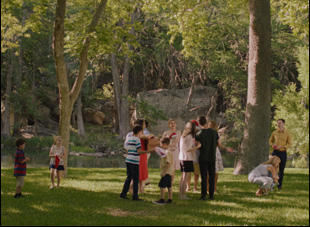
Yeah, it’s amazing. The wind was really powerful and it’s incredible how you can become blessed like that in moments on set. It was even windier than it seemed from the film. Bruce, who’s the caretaker of the property, came by — he’s quite a typical Texan that people might stereotype him as — and he really loves nature, and I think it really saddens him that he has to do certain things to keep these houses up that hurt the nature. He has to keep the sprinklers going for the grass, even though the water going to the sprinklers comes from the river and makes the [water level in the] river get lower and lower, so he was telling us about that and also about how there were like these erratic storms that were happening. That wind was unlike anything I’d really experienced in that location before. Shooting across the river at some points, I was scared that like some tree would break.
But it was really beautiful and the shot where the wind comes into the tree, it wasn’t something we waited for. It was so windy that we [thought], “Okay, we need to get some nature shots because we were actually so pressed for time,” and that was a very beautiful thing that happened to us, as well as the two birds on the rock. I don’t remember vultures coming to the rock to drink water that often when I was growing up, but they do it more now and we were doing some inserts where some of the actors would improvise or do certain actions that weren’t in the script, and one [had] the mother and the daughter, Katy and Barbara, swimming together in the river and we were shooting them. Then those birds landed there, so we tilted the camera up and captured the birds as Katie and Barbara swam toward them, and [the actors] were out of the shot at that moment, but [it felt like] they could be swimming toward the birds.
What’s it been like to get this out into the world?
It’s been great. I feel so grateful for how many people around the world have connected to this film, something that came just from my own personal life and then you bring in all these people you love to help work on it together with you. You introduce it to the programmers and it’s theirs as well — at Locarno, Eddie, one of the programmers there was saying to me before it made its premiere, “[when] it premieres, then all of us share it with the world,” and it’s beautiful how all of these different people involved bring it out to the world. So I’ve loved going all over to Egypt and to Spain and just meeting the programmers in all these places that connect so much to the film and it’s really special to me as well how a story that’s very specific can relate to all kinds of people.
I will admit I was a bit nervous what my family would think of the film, but they all really love it, so I’m really happy about that. My parents came for Locarno and my sister saw it later in Mexico City, and I think everyone relates to it in a different way and it even brings us closer a bit. My dad’s sort of obsessed with the movie. He has all these theories about where the mom goes, and then one time my sister said after the screening, “Sometimes we just go away for holiday or away for a weekend and we’re doing all these random tasks and we never really connect with one another. And that’s just how it is. That’s what it’s like to be in a family.” I thought that was really powerful. It’s been inspiring for my next projects to stay true to myself and being honest.
“Family Portrait” opens on June 28th in New York at Metrograph, July 12th in Chicago at the Gene Siskel Film Center and on July 19th and 20th in Los Angeles at Now Instant.




